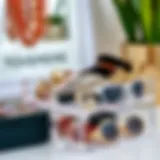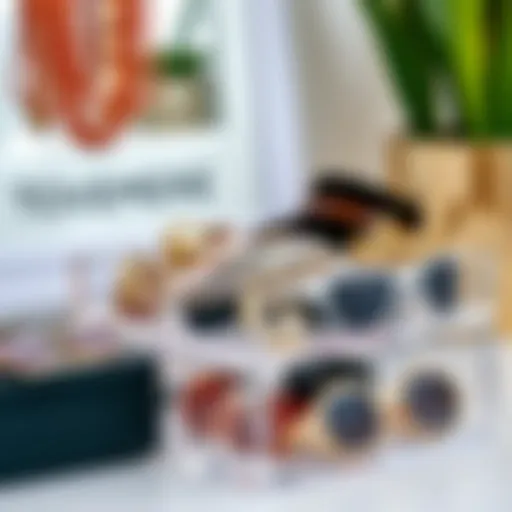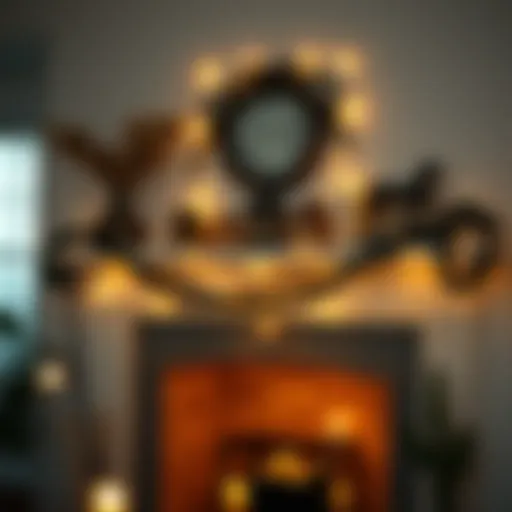The Beauty and Functionality of Artificial Hanging Vines


Intro
In the world of interior and exterior decor, fake hanging flower vines have blossomed into a popular choice amongst homeowners and designers alike. These decorative elements not only enhance the visual appeal of spaces but also provide practical benefits that live plants cannot offer. With today’s fast-paced lifestyle, many seek low-maintenance options that retain beauty without the fuss. This article navigates through the aesthetic charm and practical advantages of artificial vines, discussing their material composition, trends, and sustainability issues that arise in modern decor practices.
The intricate dance between aesthetics and functionality forms the backbone of this exploration. From understanding how these artificial marvels blend seamlessly into various decor settings to the practical considerations like care and sustainability, readers will gain a rounded viewpoint on integrating fake hanging flower vines into their homes. This conversation is not just for design enthusiasts; it's tailored to stylists, marketers, designers, and even students, enriching their understanding of contemporary decor trends.
Next, let’s traverse into the realm of Fashion Trends that incorporate fake hanging flower vines, revealing the latest insights shaping the decor landscape.
Preface to Fake Hanging Flower Vines
The world of interior and exterior decor has undergone significant changes in recent years, highlighting the shift towards integrating practical and aesthetic elements in home design. Fake hanging flower vines have carved out a niche in this evolution, offering a unique amalgamation of beauty and functionality. These decorative items bring the essence of nature indoors and outdoors without the burdensome maintenance often associated with live plants. Not only do they add a splash of color and texture to spaces, but they also cater to various preferences and lifestyles, making them an appealing choice for many individuals.
Understanding the nuances of fake hanging flower vines goes beyond mere surface appreciation; it's essential to recognize their impact on atmosphere, ease of care, and their ability to harmonize different design themes. As urban living spaces shrink, the demand for practical decor solutions has surged, making artificial floral arrangements increasingly relevant. They suit both traditional and modern aesthetics, demonstrating versatility that appeals to different aesthetic sensibilities.
Moreover, the sustainability aspect of fake hanging flower vines is quite significant. In an age where environmental consciousness is paramount, these versatile items often outshine their live counterparts, requiring no water or sunlight and lasting year after year. This longevity reduces overall waste, while still fulfilling the desire for a vibrant, greenery-laden environment.
In this article, we will delve into the many facets of fake hanging flower vines. We'll cover essential definitions, historical context, the common materials used, and their practical applications in decor. We aim to provide stylists, designers, marketers, and students with a comprehensive understanding of how to incorporate these elements seamlessly into their respective fields. The goal is to empower our readers with knowledge, enabling them to make informed decisions when choosing these beautiful and functional decor options.
"Why settle for real when faux can be just as stunning?"
Thus, the significance of understanding fake hanging flower vines cannot be overstated. They represent a blend of aesthetic appeal and practicality that aligns with contemporary living demands, enhancing spaces while catering to individual preferences.
Materials Used in Fake Hanging Flower Vines
The choice of materials in the creation of fake hanging flower vines plays a crucial role in their overall aesthetic and functional value. Understanding these materials not only elevates their beauty but also informs buyers and designers alike on how they can best harness them in various design schemes. This section will delve into the materials commonly used in these decorative pieces, the benefits they provide, as well as considerations for their sustainability.
Overview of Common Materials
Fake hanging flower vines can be constructed from a variety of materials, each contributing uniquely to their appearance and usability. Here's a closer look at some of the most frequently used materials:
- Silk: Often regarded as the gold standard, silk offers a luxurious feel and a realistic look. Its fabric can mimic the delicate texture of real flower petals, making it a favorite among decorators.
- Plastic: This is perhaps the most common material used in faux plants. It is lightweight, affordable, and easy to shape. However, the quality can vary widely, so it’s vital to choose high-grade plastic for the best results.
- Latex: This material provides an authenticity level that rivals silk. Its flexible nature allows for better detailing in leaves and flowers. Plus, it can withstand various environments without fading or discoloration.
- Foam: Increasingly used in larger installations, foam is lightweight and can be molded into elaborate shapes. It’s particularly useful for large hanging installations as it minimizes the weight that would otherwise strain hanging hardware.
- Metal and Wire: Often used in the frameworks, metal and wire provide the necessary strength and support structure. They ensure that the vines maintain their shape and can be arranged in varying forms.
Each material brings its own set of characteristics—silk gives sophistication, plastic offers durability, while latex adds authenticity. When selecting materials, it’s essential to think about the intended setting and how it aligns with the overall decor goals.
Sustainability of Materials
In recent years, the conversation around sustainability has permeated many aspects of design, and the use of materials in fake hanging flower vines is no exception. Designers and consumers alike are increasingly seeking out sustainable options that minimize environmental impact. Here’s what to keep in mind:
- Recyclability: Many manufacturers are beginning to produce faux vines made from recyclable plastics, allowing for a lifecycle that’s kinder to the planet. Look for products labeled as such.
- Biodegradable Alternatives: Some brands have started to explore biodegradable materials, which naturally break down over time, reducing the long-term waste associated with traditional faux plants.
- Durability: While it might seem counterintuitive, choosing higher-quality materials means you won’t need to replace your decor as often. This longevity contributes to sustainability, as fewer resources are consumed over time.
- Local Sourcing: Supporting local artisans or manufacturers that use locally sourced materials can greatly diminish the carbon footprint associated with transportation.
"Every small step towards sustainable choices can lead to a significant impact on our environment. Brands are becoming more conscientious about their material choices, and the market is responding positively."
In summary, understanding the materials used in fake hanging flower vines plays a pivotal role in making informed choices in home decoration, balancing aesthetic appeal with sustainable practices. By choosing wisely, both consumers and designers can enhance their spaces while also taking steps towards a healthier planet.
Design Applications in Home Decor
The importance of design applications in home decor when it comes to fake hanging flower vines is immense. These decorative elements are not just about aesthetics; they also imbue a space with character, enhance the overall atmosphere, and serve practical purposes. It’s not uncommon for individuals to employ these vines as a means to bridge the gap between nature and interior design, especially in urban settings where greenery can be scarce. The careful selection and application of faux flowers can transform dull corners into lively focal points, adding both vibrancy and warmth.
Indoor Versatility
Fake hanging flower vines demonstrate extraordinary versatility when it comes to indoor spaces. Whether draped over a doorway, cascading down a bookshelf, or framing a window, these vines can adapt to various decors and themes. For instance, a vibrant burgundy bougainvillea can add a pop of color to a minimalist room, while soft green ivy can complement rustic, farmhouse designs.
Here are some ways to utilize them indoors:
- Accent Walls: Create a living wall effect by attaching fake vines to a wall. This approach adds depth without the mess of live plants.
- Spaces Between Furniture: Use them to fill empty spaces between shelves or furniture pieces, adding layers and coziness without overcrowding.
- Event Decor: Perfect for events like weddings or parties, these can be hung from ceilings or used to adorn tables, adding elegance without the need for upkeep.
By leveraging the unique features of fake hanging flower vines, one can easily tailor the decoration to the mood one wishes to evoke. The choices are near endless, showcasing how these vines cater to practical needs while still looking good.
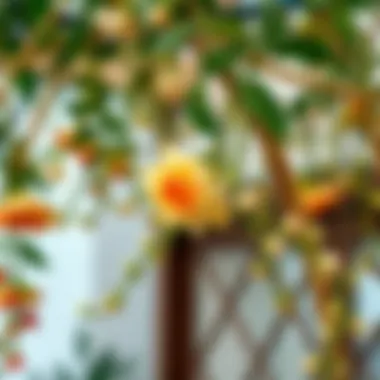
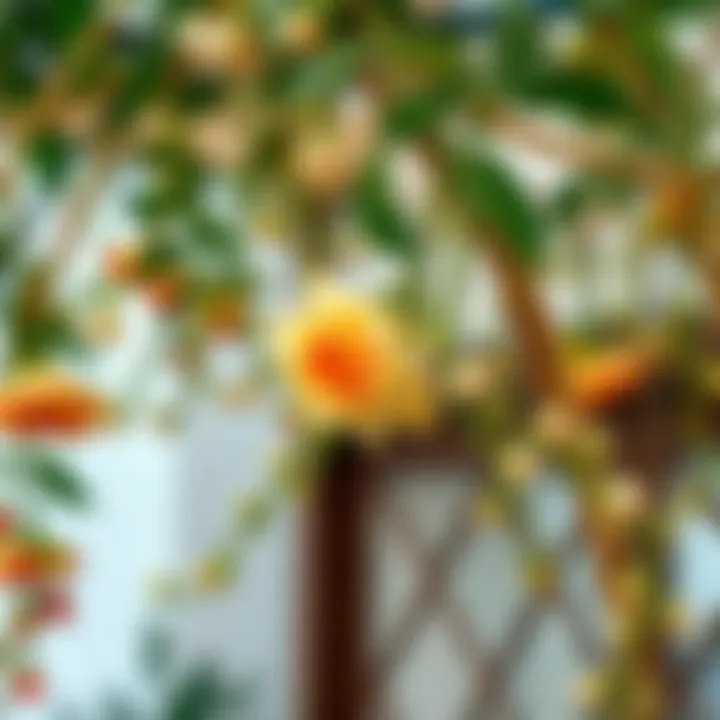
Outdoor Settings and Garden Aesthetics
When it comes to outdoor settings, the use of fake hanging flower vines offers an alluring alternative for those who cherish the beauty of nature but may struggle with live plants due to variable climates or maintenance issues. Installing these vines around patios, outdoor dining areas, or garden fences can create an inviting and lush environment, setting the stage for gatherings and relaxation.
Some benefits of using artificial vines outdoors include:
- Weather Resistance: Unlike live plants, synthetic vines withstand various weather conditions without wilting or fading, ensuring they look good throughout the seasons.
- Low Maintenance: With no need for watering or replanting, they provide a hassle-free way to keep outdoor spaces vibrant.
- Endless Variety: The color range and styles available mean one can blend styles—from tropical themes to classic gardens—without the constraints of live plant growth.
Faux vines not only contribute to the aesthetic charm but can also play a functional role, such as providing privacy and acting as a windbreak, which adds value to outdoor living spaces.
Seasonal Decoration Trends
As seasons change, so do decoration trends, and fake hanging flower vines allow for easy adaptation. They can be switched out or rearranged to reflect seasonal themes, making it simple to keep the decor fresh and engaging all year round.
For example:
- Spring Inspirations: Bright colors, like pastel roses or cheerful daisies, can be used to bring a breath of fresh air to the home.
- Summer Vibes: Utilize vines with sunflowers or tropical blooms to capture a carefree summer feel.
- Autumn Touches: Wreaths made of faux autumn leaves or vines with orange and red accents create warmth and coziness as the weather cools.
- Winter Wonder: For the festive season, consider adding vines adorned with faux snow or twinkling lights to achieve a magical effect.
Adapting to seasonal decoration trends not only keeps aesthetics dynamic but also taps into the emotional resonance that these seasonal changes evoke. By using fake hanging flower vines, decorators have the flexibility to express creativity while maintaining a cohesive look.
Maintenance and Care Factors
When it comes to fake hanging flower vines, maintenance and care are pivotal in sustaining their aesthetic appeal and longevity. Though these decorative elements do not necessitate the same level of attention as live plants, they do require certain practices to ensure they remain visually vibrant and dust-free. Understanding the nuances of maintenance not only boosts their appearance but also safeguards your investment in home decor.
Dusting and Cleaning Techniques
Keeping fake hanging flower vines looking fresh and inviting is simpler than most folks might think. Regular dusting plays a crucial role in this upkeep. Here are some straightforward techniques:
- Use a Soft Cloth or Duster: A microfiber cloth or a gentle duster is perfect for removing dust without damaging the petals or leaves. A quick once-over every week or two will prevent dirt buildup.
- Mild Soap and Water Solution: For stubborn grime, mix a few drops of mild dish soap in a bowl of warm water. Dip the cloth, wring it out thoroughly, and then gently wipe down the vines. Make sure you don’t soak them; just a light touch is sufficient.
- Avoid Harsh Chemicals: Strong cleaning agents can harm the material. Stick to natural solutions where possible. Vinegar mixed with water can be a good alternative for a balanced cleaning product.
- Air Dry After Cleaning: If you’ve used water, ensure the vines are dried completely before placing them back. This prevents mildew and keeps everything looking pristine.
By adopting these simple but effective techniques, maintaining clean and vibrant fake hanging flower vines becomes a hassle-free endeavor.
Storage Considerations
Storing fake hanging flower vines properly is just as important as cleaning them. Improper storage can lead to distorted shapes and wear over time. Here are some key considerations for storing these decorative pieces:
- Keep Them in a Cool, Dry Place: Exposure to excessive heat or moisture can warp the material. A closet or storage bin in a controlled environment is ideal.
- Avoid Heavy Weight on Top: If you’re stacking decor items, ensure that heavier objects are not resting on the vines. This can crush the petals and distort the overall look.
- Use Hangers or Hooks: A clever way to store them is on hangers or hooks. This prevents them from getting tangled or crumpled and keeps their form intact.
- Wrap with Care: If you decide to wrap them for storage, use soft fabric rather than plastic. Cloth provides protection while allowing air circulation, avoiding moisture buildup.
"The care you give your fake flower vines can extend their lifespan significantly, ensuring they remain appealing for years to come."
Following these storage tips can make a world of difference, preserving the intricate designs and vibrant colors that fake hanging flower vines bring into your living spaces.
Aesthetic Impact on Atmosphere
Understanding the role of fake hanging flower vines in shaping the atmosphere of a space goes beyond mere decoration; it taps into deeper emotional and psychological dimensions. Aesthetics can influence mood, perception, and even social interactions. When it comes to interior and exterior design, the choice to incorporate artificial greenery speaks not just to style but also functionality. Producing vibrant visuals without the recurring responsibilities associated with live plants offers unique advantages.
Fake hanging flower vines create an illusion of life and warmth within spaces that might otherwise feel sterile or uninviting. They can soften architectural lines, enrich color palettes, and add layers of texture. Moreover, they require no sunlight, which allows them to flourish in places where natural light is nonexistent. Designers often harness this quality to infuse life into dim corners, enhancing the overall ambience without worrying about sun exposure or maintenance.
Creating a Welcoming Space
The deliberate choice of flowers and colors in fake hanging vines can significantly influence how a space is perceived. A lush green vine with bursts of pink blossoms can convey a sense of cheerfulness, making entryways and living areas feel more inviting. In contrast, muted tones such as pale pastels or earthy hues might instill calm and serenity, perfect for a home office or relaxation zone.
Here are a few considerations that make fake hanging flowers ideal for creating welcoming environments:
- Non-Invasive: They set the stage without cluttering. A carefully placed vine above a doorway or along a shelf can enhance a space's warmth without overpowering other elements.
- Versatility in Style: Whether it’s rustic farmhouse or sleek urban minimalism, there’s a vine to complement every aesthetic, making it easy to craft a welcoming feel in diverse environments.
- Ease of Installation: Unlike live plants, fake vines can be easily hung from ceilings and walls. This flexibility allows for creative arrangements that suit the unique contours of a space.
Color Psychology and Visual Appeal
Venturing into the realm of color psychology reveals fascinating layers about how hues from fake hanging flower vines can affect our moods. Each color invokes a different emotional response:
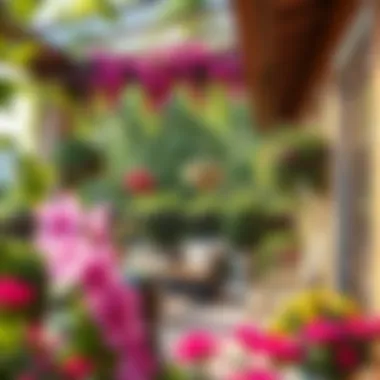
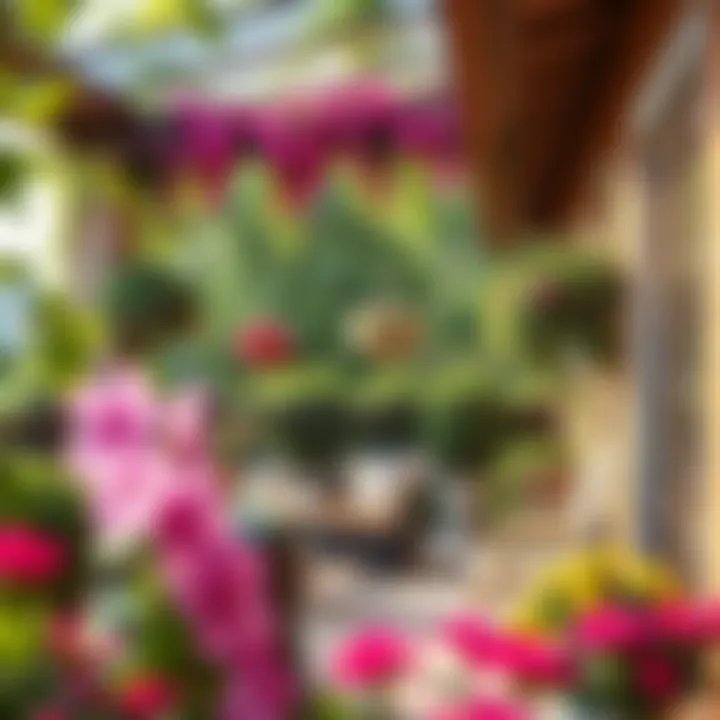
- Green: Often associated with nature, growth, and tranquility. A wall draped with green vines can create a restful space that fosters creativity and calm.
- Red and Pink: These warm tones can incite feelings of happiness and excitement, making them suitable for social areas like dining rooms or lounge spaces.
- Yellow: Known for uplifting energy, yellow-hued flowers can stimulate optimism and joy, perfect for spaces meant to inspire.
Incorporating color psychology through artificial flower vines means harnessing deliberate choices to enliven or soothe. This thoughtful approach can transform an ordinary room into an almost enchanting environment.
"When designing a space, don't just fill it with items; fill it with stories and emotions. Fake flower vines can narrate tales of warmth, invitation, and serenity.”
In summary, fake hanging flower vines serve as more than just decorative pieces. They hold the potential to recreate moods, draw people in, and even encourage engagement—traits that are essential in every space, be it domestic or commercial. By blending aesthetics with practical considerations, they contribute significantly to creating a harmonious atmosphere.
Comparative Analysis: Fake vs. Live Plants
When it comes to enhancing decor, a significant decision arises between opting for fake hanging flower vines or their live counterparts. This choice is more than a simple aesthetic preference; it intertwines with lifestyle choices, maintenance capacities, and even emotional well-being. Understanding the nuances of both options allows for a well-rounded decision that doesn’t only fit a specific taste but also aligns with practical living. In this section, we will dissect the pros and cons of each option, as well as how personal preferences and lifestyle choices can steer this decision.
Pros and Cons of Each Option
Fake Hanging Flower Vines:
- Pros:
- Cons:
- Low Maintenance: Unlike live plants, fake vines do not require watering, sunlight, or special attention, making them suitable for busy professionals or those without a green thumb.
- Versatile Aesthetics: These artificial adornments come in various designs and colors, enabling customization to fit different decor styles.
- Consistent Look: Fake vines maintain their vibrant appearance year-round without wilting or fading, ensuring a steady aesthetics.
- Lack of Freshness: The absence of aroma and organic feel can be a downside for many who cherish the sensation brought by living flora.
- Quality Variation: Not all artificial flowers are created equal; some may look excessively synthetic or cheap.
- Dust Accumulation: Without regular cleaning, they can attract dust, which can spoil their visual appeal.
Live Plants:
- Pros:
- Cons:
- Air Purification: Many live plants clean the air by absorbing toxins, making them conducive to a healthier indoor environment.
- Natural Growth Cycle: Watching a plant grow can provide immense pleasure and a sense of achievement, fostering an emotional connection.
- Dynamic Aesthetics: Live plants change with the seasons, reflecting a natural evolution in your decor.
- Maintenance Requirements: Live plants need regular watering, appropriate sunlight, and sometimes, pruning or fertilizing.
- Potential for Allergens: Some individuals may suffer from allergies related to plant pollen.
- Limited Longevity: Plants can wither and die, leaving behind either an empty space or a challenging removal task.
"Choosing between fake and live plants isn’t just about looks. It’s about lifestyle, care, and personal connection."
In weighing your options, consider not just the immediate visual appeal but how much effort you’re able and willing to invest in your plants.
Personal Preferences and Lifestyle Choices
Personal preferences play a pivotal role in the fake vs. live plants debate. For those leading frenetic lives, embracing the ease of artificial vines can provide aesthetic fulfillment without the hassle. Alternatively, individuals who relish nurturing living things may find fulfillment in cultivating real plants, embracing the cycles of growth and decline.
Also, consider your living environment and daily routines. A bustling city apartment may not offer adequate light for live plants, pushing one towards the vibrant hues of synthetic options. Conversely, a spacious home with a garden opens doors to real blooms, echoing a connection to nature.
Ultimately, the decision between fake and live plants isn’t cut and dried; it is a reflection of personal preferences, practical considerations, and the ambiance one hopes to achieve in their space. As such, it invites reflection on not only aesthetic desires but also lifestyle capabilities. This analysis lays a foundation for making an informed choice that resonates with your personal and practical decor aims.
Market Trends and Industry Insights
The world of decor is ever-changing, shaped by consumer interests and broader social trends. Examining market trends and industry insights related to fake hanging flower vines helps us grasp their place in today’s aesthetic landscape. As more people lean towards low-maintenance lifestyle choices, decorative expressions through faux plants gain traction. These trends not only influence purchasing behaviors but also reflect deeper shifts in how we view our living spaces.
Current Trends in the Decor Industry
In recent years, there's been a noticeable shift in interior design where sustainability meets style. Consequentially, fake hanging flower vines have found their niche. Gone are the days when artificial flowers were relegated to a dust-ridden corner; nowadays, they're center stage, pleasing the eyes and the budget. Some factors driving this trend include:
- Realism of Design: Advances in manufacturing have resulted in fake vines that look strikingly real. Textures and colors have improved, leading to a more desirable aesthetic.
- Low Maintenance Appeal: Consumers are busier than ever; thus, the low maintenance nature of artificial plants resonates well. No watering or pruning! Just enjoy their beauty without the fuss.
- Diverse Applications: From minimalist apartments to lush, bohemian styled homes, these vines can fit in anywhere. People are using them creatively in wall décor, as table centerpieces, or to add charm to any corner of a room.
This increasing acceptance of faux decor items reflects broader trends in the decor industry, where the lines between natural and artificial are becoming less defined.
Consumer Preferences and Buying Patterns
The way consumers approach purchasing faux flower vines is telling. Understanding these preferences can illuminate what drives their decisions. Some recurring themes include:
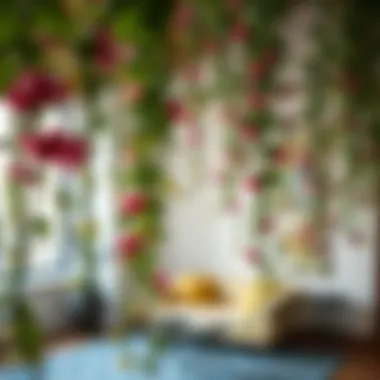
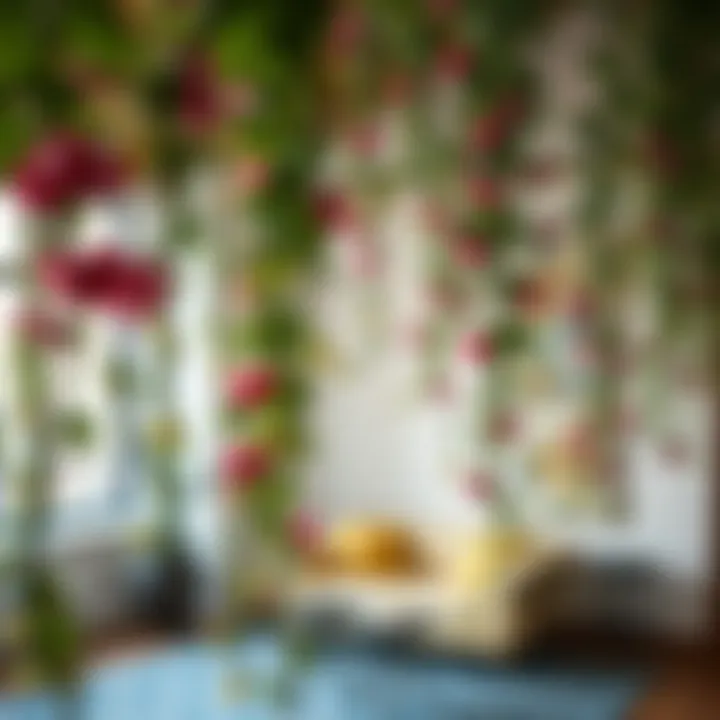
- Value for Money: Shoppers are now considering long-term value. With a faux vine, you're investing in a piece that can last for several years, unlike live plants which can be costly over time.
- Convenience and Versatility: Many prefer an item that can easily transition between different decor styles or seasons. Fake hanging flower vines serve that purpose beautifully, allowing creative flexibility without commitment.
- Online Shopping Shift: E-commerce has made it simpler for consumers to shop for decor items from the comfort of their homes. Sites like Wayfair and Etsy are increasingly popular for finding unique and personalized faux plants, influencing buying patterns positively.
It’s worthwhile to note that while the preference for fake plants is on the rise, many consumers seek a balance. They appreciate the presence of natural elements among their artificial décor, fostering an eco-friendly ambience even in artificial displays.
"Understanding market trends provides businesses and consumers alike with the knowledge to make informed decorating choices that echo today’s values."
This exploration of trends and preferences isn't merely academic; it arms designers, stylists, and marketers with insights. As they develop marketing strategies or curate collections, this knowledge can guide them to meet evolving consumer needs effectively. Such depth in understanding underscores the relevance of fake hanging flower vines in contemporary decor.
Cultural Considerations
Exploring how fake hanging flower vines fit within diverse cultural landscapes reveals significant insights. This aspect emphasizes how decor choices are not solely about aesthetics or practicality but are also deeply intertwined with cultural symbolism and history. Understanding these cultural considerations can provide a deeper appreciation for what these decor elements signify and how they are integrated into various traditions and practices. This section explores the symbolism of flowers across different cultures, as well as how decor practices are evolving in response to changing societal values.
Symbolism of Flowers Across Cultures
Flowers have long served as powerful symbols in human culture. In many societies, they represent love, hope, and even mourning. For instance, in Japan, cherry blossoms symbolize the fleeting nature of life. In contrast, the lotus holds a prominent place in Indian culture, symbolizing purity and rebirth. Fake hanging flower vines serve as a bridge to these meanings, offering a way for individuals to incorporate floral symbols without the necessity of maintenance or seasonal constraints.
When people decorate spaces with these artificial vines, they often do so to invoke certain feelings or ideas associated with these flowers. For example, using fake lavender might not just enhance a room's beauty, but also evoke tranquility, pulling from lavender's longstanding association with calmness in various cultures.
Moreover, the use of floral decor can also convey cultural identity. Take the Mexican Día de los Muertos as an example; marigolds are a vibrant part of the holiday, symbolizing the link between life and death. By incorporating similar designs in their décor, individuals express cultural heritage, making fake hanging flower vines an accessible option for those wanting to celebrate or honor their cultural roots.
Cultural Shifts in Decor Practices
As we navigate through contemporary spaces, the fluidity of cultural practices in decor becomes strikingly apparent. With globalization, many cultures find themselves blending ideas and aesthetics, leading to a new harmony in decor practices. This fusion is particularly visible in urban environments where diverse communities coexist. Here, fake hanging flower vines emerge not merely as decoration but as symbols of this cultural amalgamation.
Through these vines, people are not restricted to traditional design norms. Instead, they can personalize their environments by opting for flowers that may not be of local origin but resonate with them on a personal level. For instance, the popularity of tropical plants in interiors has surged in areas far removed from tropical climates. This shift illustrates how artificial aesthetics allow for a more diverse representation of personal identities within home decor.
A point to consider is sustainability; as more decorators aim for eco-friendly solutions, the shift toward artificial flowers grows stronger. This transition reflects an understanding of the environmental impacts of maintaining live plants, encouraging people to adopt practices that consider both aesthetics and environmental conscience.
Future of Fake Hanging Flower Vines
The trajectory of fake hanging flower vines seems to align perfectly with the modern aesthetics of interior and exterior design. As the world leans into sustainable living and technological advancements, the future of these decorative elements is poised for innovative transformation. It’s crucial to recognize that fake hanging flower vines are no longer just about ornamental value. They embody functionality, adaptability, and smart design while remaining eco-conscious.
One significant aspect to explore is the integration of smart technology into these decorative features. Consider how the typical fake vine can evolve; think of color-changing LED lights integrated within the vines to mimic seasonal changes or temperature variations. Such innovations would not just add a whimsical touch but also give homeowners a sense of control over their environment. The more we can personalize our spaces to reflect our moods, the more satisfying our living experiences become.
Innovative Designs and Smart Technology
The landscape of design is ever-changing, and the advancements in technology can make fake hanging flower vines more appealing than ever. Imagine a future where vines are embedded with sensors, allowing them to adjust their appearance based on the ambient light or room conditions. This kind of adaptability adds a layer of interactivity. For instance:
- Smart vines could change their foliage or flower colors based on the time of day, promoting a calm vibe in the morning and an energizing atmosphere in the evening.
- Some designs might even include sound components, playing gentle sounds of nature, enhancing the relaxation factor in any space.
- Partnerships with home automation systems could allow these vines to synchronize with other smart devices, changing hue or adjusting their position based on daily routines.
This innovative approach isn’t merely about aesthetics. It reflects changing consumer preferences, emphasizing a deeper connection between decor and well-being. Integrated smart technologies elevate the utility of fake hanging flower vines, making them functional art pieces.
Sustainability in Production Processes
As the environmental conversation becomes more pressing, it’s imperative to discuss sustainability in the production of fake hanging flower vines. Today’s conscientious consumers often seek products that are not just visually appealing but also made with eco-friendly practices. Brands are increasingly challenged to reduce their environmental footprint and improve their sourcing methods.
The future of fake hanging flower vines may involve:
- Eco-friendly materials: Using recycled plastics or biodegradable components will likely become a standard. Consumers are more inclined towards materials that do not contribute to pollution or landfill waste.
- Ethical manufacturing: Transparency in supply chains will be critical, ensuring that production processes do not exploit labor or resources. Brands showcasing ethical practices will likely attract more interest.
- Long-lasting durability: Higher quality materials can enhance the longevity of fake hanging flower vines, reducing the need for frequent replacements and promoting prolonged use.
Adapting manufacturing processes not only aligns with growing sustainability trends but also appeals to a market looking for responsible purchasing choices. As designers leverage eco-conscious practices while innovating, the artificial greenery landscape can transform into a realm where beauty and ethics coalesce harmoniously.
"When design meets sustainability, the potential for innovation becomes limitless."
In summary, the future of fake hanging flower vines is entwined with technological advancements and a commitment to sustainability. As they evolve to meet aesthetic and practical demands, these decorative elements are set to become indispensable in both residential and commercial spaces.
Closure
The conclusion of this exploration serves to encapsulate the vital elements regarding fake hanging flower vines and their multifaceted role in decoration. A comprehensive understanding of these elements not only reflects the growing popularity but also sheds light on the practical advantages they offer to various spaces.
Summary of Key Points
To summarize, the adoption of fake hanging flower vines has surged, propelled by several noteworthy factors:
- Aesthetic Versatility: These vines can transform a mundane room into an inviting haven. Their ability to seamlessly integrate into various design schemes, from minimalist to bohemian, is astonishing.
- Low Maintenance: Unlike live plants, these faux alternatives require little care — no watering, pruning, or specific lighting conditions are needed. This ease of use appeals to busy individuals who still want to elevate their environment's beauty.
- Customizable Options: Today's market offers a plethora of styles, materials, and colors, allowing users to select designs that resonate with their personal preference or current trends, echoing individuality in every setting.
- Sustainability Considerations: As consumers become more eco-conscious, the sustainable production processes of high-quality faux vines make them an appealing choice, breathing new life into spaces without the environmental costs associated with live plants.
- Cultural Relevance: The symbolism behind flowers varies significantly across cultures, and incorporating fake hanging flower vines offers an opportunity to embrace these meanings without the impermanence associated with live plants.
